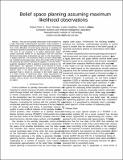Belief space planning assuming maximum likelihood observations
Author(s)
Platt, Robert; Tedrake, Russell Louis; Kaelbling, Leslie P.; Lozano-Perez, Tomas
DownloadTedrake_Belief space.pdf (172.6Kb)
OPEN_ACCESS_POLICY
Open Access Policy
Creative Commons Attribution-Noncommercial-Share Alike
Terms of use
Metadata
Show full item recordAbstract
We cast the partially observable control problem as
a fully observable underactuated stochastic control problem in
belief space and apply standard planning and control techniques.
One of the difficulties of belief space planning is modeling the
stochastic dynamics resulting from unknown future observations.
The core of our proposal is to define deterministic beliefsystem
dynamics based on an assumption that the maximum
likelihood observation (calculated just prior to the observation)
is always obtained. The stochastic effects of future observations
are modelled as Gaussian noise. Given this model of the dynamics,
two planning and control methods are applied. In the first, linear
quadratic regulation (LQR) is applied to generate policies in the
belief space. This approach is shown to be optimal for linear-
Gaussian systems. In the second, a planner is used to find locally
optimal plans in the belief space. We propose a replanning
approach that is shown to converge to the belief space goal
in a finite number of replanning steps. These approaches are
characterized in the context of a simple nonlinear manipulation
problem where a planar robot simultaneously locates and grasps
an object.
Date issued
2010-06Department
Massachusetts Institute of Technology. Computer Science and Artificial Intelligence Laboratory; Massachusetts Institute of Technology. Department of Electrical Engineering and Computer ScienceJournal
Proceedings of the Robotics: Science and Systems Conference (RSS)
Citation
Platt, Robert, Jr., et al. "Belief space planning assuming maximum likelihood observations" Proceedings of the Robotics: Science and Systems Conference, 6th, 2010.
Version: Author's final manuscript